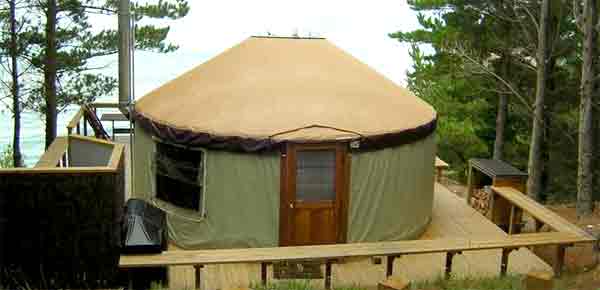Yurts as Full-Time Tiny Houses
Living full-time in a yurt: is it legal? Is it safe? And lastly, is it practical? I’ve hesitated doing a page on yurts as full-time housing because I see the problems first. But for many people, yurt-living works. Let’s take a look at the pro(s) and cons so you can determine if one of these charming abodes would work for you.
Problems with Yurts as a Full-Time Residence

I helped John and Fin from United Tiny House Association assemble their yurt at the 2018 Peoples Tiny House Festival. It stood up to high winds and a storm that brought all the other tents to the ground.
I’m going to mention the cons first. If these do not dampen your enthusiasm, then yurts might be an affordable housing option for you.
- Rodents, bugs, and other small animals will be your constant companions.
- Bears can tear right thru the fabric walls (see video below). You would need to add a bear-proof enclosure around the entire property as a proper deterrent if you live in bear country.
- Yurts are not soundproof. Anyone outside or a nearby neighbor will hear you. You will hear all of the sounds of the environment you live in.
- Most places do not have building codes for yurts and will not approve them for full-time occupancy. Websites that claim you can live in them full-time give you a list of ways you can circumvent the building codes and zoning laws.
- A yurt is simply an insulated tent. Heating and cooling take a lot of effort and expense.
- Yurts are usually made of canvas that is prone to mold, mildew, and tearing. Canvas deteriorates quickly.
- There are no rain gutters so water runs down (and through) the walls.
The Upside of Yurt Living
- Actually, there is only one advantage I can think of. Since they are simply glorified tents, they are a relatively inexpensive choice for the structure alone.
An Example of the Best Possible Scenario
The Hawaiian work-around
In Hawai’i, yurts are not legally allowed as permanent housing structures. However, buildings under 220 sq/ft. do not need permits. So, as long as it’s under that size, you can probably erect the structure. However, the building codes in most places do not allow them to have plumbing or electricity. To get around that, can add solar power and an outdoor toilet.
Yurts of Hawai’i helps people deal with Hawaii’s building codes to stay within the law. Located on the Big Island of Hawai’i, Yurts of Hawai’i helps design yurts best suited to your needs and budget. They will also do the setup when your custom yurt arrives. Their yurts are built by Colorado Yurt Company (see photo above).
Yurts are fairly safe housing in Hawaii (no bears, but they do have huge rats and nasty centipedes) and the need for affordable housing is great. Keep in mind that there is no way to really secure a fabric dwelling, so you wouldn’t want to leave anything valuable unattended.
In Hawaii you are required to have a cistern for rain catchment. A 10,000 gallon tank can be as big as the yurt. That means the yurt would need to be designed with some kind of a rain gutter system to divert the rain into the tank.
Here is a YouTube® video by Yurts of Hawaii
Yurts Need to be Erected on a Sturdy Base
You will need to construct a sturdy foundation for your yurt before it arrives. Most people build a wooden deck for this purpose. It’s recommended to be at least a couple feet above the ground so you can get plumbing and electrical into interior walls as needed.
The foundation could also be concrete, but the experts recommend it be at least 5″ above the surrounding ground level. A concrete pad would also need a circular sill plate made of wood to attach the yurt to.
You can download plans from Pacific Yurts, Inc.
Yurts are Not Bear-Proof
Here is a YouTube® video of a couple living off-grid in a yurt in Port Hardy, British Columbia. They have a really good channel with many videos of their situation.
This video shows the damage done by a hungry bear. The walls are fabric and the windows are plastic.
These folks are able to live in a yurt because they are in an area where there are no government agencies enforcing building codes or zoning laws. They chose to construct a yurt because of the difficulty of getting building materials to their land.
Where yurts can be used
I had friends who were allowed to live in a yurt temporarily while they built their house. They liked it so much that they left it up as a guest house in the backyard. It was allowed as a temporary shelter.
I knew another couple who had a yurt on their remote mountain property that they visited once in a while. They never left food in it when they weren’t there.
Rent a Yurt right on Sunset Beach, on Oahu Hawaii
From their ad: “Stay in a beautiful 16ft Mongolian loft yurt right by world famous Sunset Beach. This yurt is built above ground on solid pine decking. The loft houses a Queen bed which allows you to look out at the stars through the big clear dome in the center of the roof. Bountiful natural light floods in during the day, and below the loft is a couch area with a hanging lounge chair, AC unit, and mini fridge. The inside is decorated and built with many unique touches to make your stay one of a kind!”



